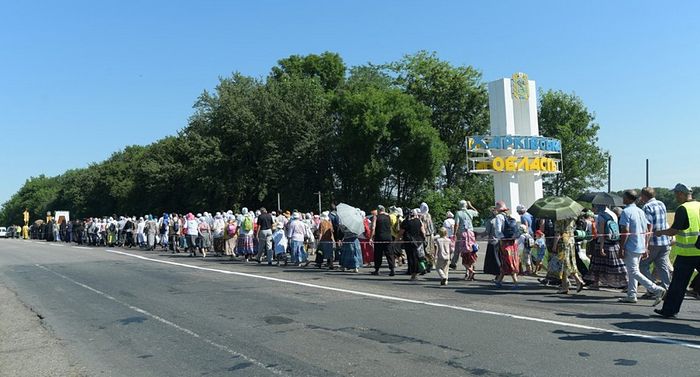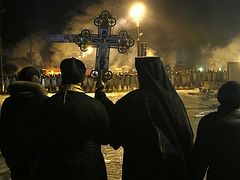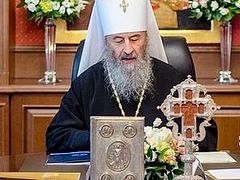It has been a long time sine the Ukraine has been the leading story in Russian news, and has been only one of the many news items. Now if you look at what the social networks are discussing you’ll immediately see that there are other things on people’s minds—Trump, Syria, pension reforms, Skripal, sanctions, and finally video clips of the popular singers Kirkorov and Baskov.
In the space of Russia Church media, until only recently it was much the same—one only has to leaf through the earlier news headlines and articles. And when the representatives of the Constantinople Patriarchate suddenly made a series of extremely sharp pronouncements, no one noticed it at first, even up to the moment that he sent two exarchs to Kiev.
Only now are many beginning to understand that something serious has taken place. However, the only conclusion one can draw from the squall of discussion is that people often simply do not imagine the reality in which the faithful of the Ukrainian Orthodox Church have now found themselves.
That is why I, a parishioner of the Ukrainian Orthodox Church [the autonomous Church headed by Metropolitan Onuphry, under the Moscow Patriarchate.—Trans.], living in Kiev, would like to show you the situation from the inside, from the very epicenter.
For example, in the blogosphere you can hear more and more often, “Just give them autocephaly for heaven’s sake, it will solve all the problems!”
I am disappointed. It won’t. Let’s take a look at these problems honestly and without embellishment.
Hypothetical autocephaly for the Ukrainian Orthodox Church is often presented as the best medicine for schism. Those who think so simply don’t understand the specifics of the Ukrainian schism. By Church schism is usually understood a situation when a certain portion of the clergy and laity split from the unified Church, as a rule due to dogmatic reasons. But the Ukrainian schism cannot be compared with the schism of 1054, nor with the Old Believers schism in the seventeenth century. This one is entirely different.
I will simply recall the situation. On the cusp of the 1980s-90s, when in Western Ukraine began massive forceful seizures of Orthodox churches by the Uniates, certain representatives of the clergy decided that they will not be harrassed if they remain Orthodox but leave Moscow. In any case, that is how the autocephalists explain their actions.
I will not retell here the history of the autocephalous “churches”, for the reason that by naming off all of these “Ukrainian Orthodox Autocephalous Churches”, “Ukrainian Orthodox Autocephalous Churches by Concilliar rights” and all the other “Kiev Patriarchates”, their unions and divisions, we might miss the essence.
And the essence is this: Two or three former hierarchs of the Russian Orthodox Church created their own completely new hierarchy and ordained their own new clergy. Today, these structures are denominations that are not in any way connected in their past with either the Russian Orthodox Church in general, nor the canonical Ukrainian Orthodox Church in part. The only one with such a “past” is Philaret Denisenko.1
In other words, this is not even a schism, but a sort of Philaret sect. The main difference of this schism is the absence of dogmatic arguments. Theology in fact plays no part whatsoever. The Ukrainian schismatics of all stripes are united by one thing: phyletism and hatred for Moscow.
Amongst the faithful of the Ukrainian Orthodox Church are people of various political views, but they are all united by the most important thing: faith in Christ. For the schismatics, faith takes second place against the background of their fetish in the form of nationalism.
These people [the schismatic groups] systematically forcefully take over our churches, beat up our priests and faithful, sic radical nationalists on us, slander us and accuse us of state treason. Therefore we are perplexed when some Church fringe polemicist suddenly starts worrying about the fate of our persecuted brothers, and for the sake of their persecutors suggests that the Ukrainian Orthodox Church be given autocephaly in order to create for nationalism-obsessed individuals with a fragile emotional makeup and who are suffering so greatly only from commemorating the Patriarch of Moscow and all the Russias, comfortable conditions for returning to the Church.
But here is the problem: They essentially never were in the Church. That is, there is no talk of returning.
Our Church hierarchy constantly emphasizes that the schism can only be overcome after the schismatics repent. And this does happen. Separate individuals come from time to time to the Church with repentance, and the Church receives them. It precisely receives living people who have recognized the whole catastrophe and sin of schism. And here we have to be realistic. We will not be able to bring all of them into the Church, especially from those spheres that are filled with hatred. And we especially cannot close our eyes and pretend that there is no hatred.
We are essentially being offered to receive unrepentant persecutors into Eucharistic communion without any conditions whatsoever. They do not recognize their disaster. And the problem of these people is not in that they supposedly love Ukraine, but in the fact that they hate Moscow more than they love Ukraine and God.
Now about the status of autocephaly.
Autocephaly in and of itself, if the Russian Orthodox Church should grant it, does not mean automatic acceptance on the part of Constantinople, or that peace will be restored. Do we have to recall again the fate of the Orthodox Church of the Czech lands and Slovakia, which received autocephaly from the Moscow Patriarchate in the distant year of 1951? The Phanar did not recognize this autocephaly for nearly a half a century and only in 1998 gave it its own tomos—after which representatives from Constantinople began to behave on the canonical territory of the Czech Church as if they were in their own home. Obviously the hypothetical Ukrainian autocephalous Church can expect the same fate. This is not even to mention any other structure created by Constantinople itself, be it an autonomous Church or an exarchate.
This summer, the hierarchs of the Ukrainian Orthodox Church in the person of its bishops—the participants of an assembly of bishops—proclaimed that the existing status of the Ukrainian Orthodox Church is quite adequate for the fulfillment of their mission amongst the people of the Ukraine.
I would also add that this is the only possible status in our contemporary situation, when a fratricidal war is raging in our country and the faithful are located on different sides of the front.
The Ukrainian Orthodox Church is entirely independent in its self-rule—more independent than some autocephalous Churches. However, at the same time, its episcopate can participate in the Council of Bishops of the entire Russian Orthodox Church, and the Metropolitan of Kiev is a permanent member of the Holy Synod of the Russian Church. This status is unique in its own right, and allows for maximum use of the Church’s peacemaking mission. Take this away, and you only multiply the problems.
But the most important question is this: Can the people of the Church accept an autocephaly that means knowingly uniting with its own persecutors, who can then receive their canonical status from Constantinople? From that same Constantinople that earlier repeatedly declared its support for the canonical Ukrainian Church, and now suddenly denies its own words for the sake of its own ambitions?
Most often we can hear talk of “giving away” the Ukrainian Church from representatives of Moscow’s Church fringe liberal cliques, whose concepts of Ukrainian Church problems are built upon the fantasies of that same kind of clique, only Kievan. Each one as a rule associates with those of their own ilk. But the autocephalous dreamers from Kiev see and hear only their own selves. We, however, associate with people from various strata of the whole Ukraine. With bishops, and priests, monks and laity. They all have their own views, longings, fears, and hopes. I repeat, that it is all much more complex than what once-popular missionaries who have re-qualified themselves as scandalous bloggers2 and former Patriarchate bureaucrats gone malcontents imagine.
Just how many faithful of the Ukrainian Orthodox Church came out for the Cross Processions in all the cities and town of the Ukraine on the days of the Baptism of Rus’ was seen by the whole world. Those are the faithful whom others now want to shove into a ghetto. These are millions of living people. They a people who from generation to generation have lived in these lands, whose grandfathers and great-grandfathers lived through persecutions, and those who now experience persecutions themselves.
Giving in now to the persecutors, giving in to the ambitions of the Phanar bishops, giving in to those who these same bishops are pushing towards a confrontation, means only one thing: throwing the Ukrainian Orthodox Church, which is already experiencing persecution, completely to the wolves.
As soon as a parallel, formally canonical structure having no relation to the Russian Orthodox Church appears on the territory of the Ukraine, the already existing canonical Church can be simply declared outlawed—about which government representatives have already spoken many times. And if the forceful seizure of churches has heretofore been considered something objectionable at least from the jurisdictional point of view, then now all of these raids will receive governmental sanction. And we won’t be able to do anything about it; we can only die defending our holy sites.






